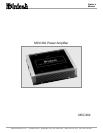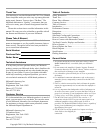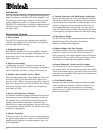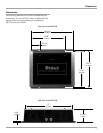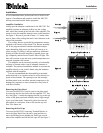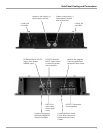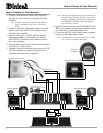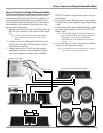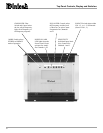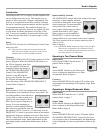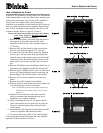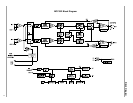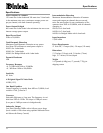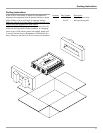
11
How to Operate
Introduction
The McIntosh MCC302 is a highly versatile amplifier that
can be configured in many ways. This manual gives ex-
amples of some of the most common configurations. The
best way to set equalization and filter controls is through
the use of a real-time spectrum analyzer and the expertise
of a professional installer. This manual will guide you
through the basic operation, however we suggest you refer
to your dealer for further information on the use of this
unit. To access the Amplifier Controls and Switches refer
to Removing the Glass Panel located on page 6 of this
Owners Manual.
Power
The MCC302 will turn On or Off when the Control Center
turns On or Off.
Note: There must be an Amp ON connection between the
MCC302 and the signal source unit in order for the
amplifier power turn On and Off to function.
Crossover
The CROSSOVER Switch OUT Position selects a Flat Fre-
quency Response. When the CROSSOVER Switch is in
the LP (low frequency pass) Posi-
tion, the Amplifier will pass all
frequencies below the setting of
the CROSSOVER FREQUENCY
Control. If the CROSSOVER
Switch is in the HP (high fre-
quency pass) Position, the Ampli-
fier will pass all frequencies
above the setting of the CROSSOVER FREQUENCY
Control. Refer to figure 4.
Equalizer
Both channels (1 and 2) are equipped with an equalizer.
The equalizer is not intended to act as a tone control. The
one-band equalizer is best utilized as
a notch filter to reduce a peak (as lo-
cated by real-time analysis with an
RTA) in your systems frequency re-
sponse. If you are attempting to
equalize a system without RTA data,
play music you are familiar with, set
the equalizer LEVEL Control to +12 and slowly turn the
FREQUENCY Control to get an idea where in the musical
spectrum the frequency numbers are located. Then set the
LEVEL Control back to 0 and listen to the system to deter-
mine its equalization needs. Subtle adjustments are best
and cutting usually sounds better than boosting. Refer to
figure 5.
Input Sensitivity Controls
The SENSITIVITY controls allows the setting of the input
sensitivity, of both amplifier channels,
to provide an ideal match for the signal
source being used. The most desirable
setting allows the control center to
have a useful volume range as wide as
possible from loud to soft. A good
place to start is to set the amplifiers
SENSITIVITY Control to the output
voltage called out in your control center owners manual.
The Level controls can be set for any sensitivity from .5
volts to 8 volts.
Refer to figure 6.
Note: In BRIDGE MODE Sensitivity Control 2 has no effect.
When used in conjunction with a McIntosh Control
Center, you may find setting the Sensitivity controls to
the center detent (1.5V) works best.
Operating in Two Channel Mode
Operating in Bridged Subwoofer Mode
Input Source
Set the Input SOURCE Switch to the 1, 2
position. Refer to figure 7.
Mode
Set the MODE Switches to the STereo posi-
tion to configure the amplifier for two chan-
nel operation. Refer to figure 8.
Crossover
Set the CROSSOVER Switch to the OUT position since
both channels are operating at full frequency range. Refer
to figure 4.
Input Source
Set the SOURCE Switch to the 1-2 (SUB)
position. Refer to figure 7.
Output Mode
Set the MODE Switch to the BRIDGED Po-
sition to operate in the Bridged Subwoofer
Mode. Refer to figure 8.
Crossover
Set the CROSSOVER Switch to the LP Position. Adjust
the CROSSOVER FREQUENCY Control for the Cross-
over Frequency that is recommended by the Manufacturer
of the Loudspeaker for the best performance. Refer to fig-
ure 4.
Figure 4
Figure 5
Figure 6
Figure 8
Figure 7



